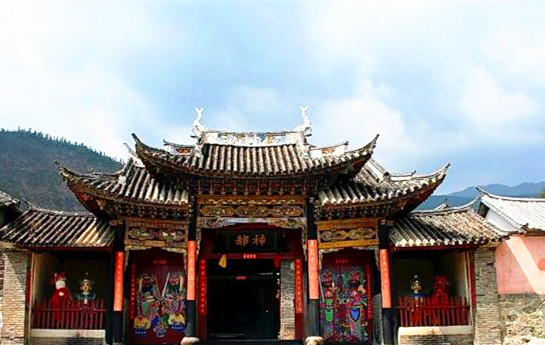Cangshan Shenci Temple (苍山神祠) is located about 2000 meters west of Dali Ancient City (大理古城) in Dali Bai Autonomous Prefecture (大理白族自治州), Yunnan Province (云南省). Nestled at the southern foot of Zhonghe Peak (中和峰) of Cangshan Mountain (苍山), it faces Zhongxi River (中溪) and is surrounded by mountains to the west and north. Originally built during the Nanzhao period (南诏), the temple was renovated during the Qing Dynasty (清) under the Jiaqing (嘉庆) and Daoguang (道光) reigns.
Historical Significance
Cangshan Shenci Temple is historically important as the site of the alliance between Nanzhao and the Tang Dynasty (唐朝). The temple complex includes a gate tower, a main hall, and two side pavilions, covering 1,411 square meters in a traditional quadrangle layout. The main hall has five bays, with a hipped roof 14 meters long, 8 meters high, and 10.3 meters deep. The gate tower features a single-eave hard roof, 10.2 meters wide and 7 meters deep, with a stage at the back.
The temple is recognized as a witness to events reflecting ethnic unity and national integrity. In 1985, it was designated a key municipal-level cultural relic protection unit, and in 1987, it was recognized at the provincial level.
Historical Evolution
- Nanzhao Period: Temple first established.
- Ming Dynasty: Rebuilt in 1528 and 1552.
- Qing Dynasty: Restored in 1692 and 1875–1908 after damage during Xianfeng (1851–1861) and Tongzhi (1862–1874) periods.
- Republic of China: Restored in 1945 by local elites.
- 1988: Community-led fundraising led to further repairs.
Architectural Layout
Cangshan Shenci Temple follows a quadrangle layout with a gate tower, one main hall, and two side pavilions. The main hall houses a central stone tablet inscribed with “Chifu Diancang Zhaoming Zhengguo Lingdi Shenwei” (敕封点苍昭明镇国灵帝神位), highlighting its cultural and historical importance.
Main Hall:
- Five-bay structure
- Hipped roof
- Dimensions: 14m × 8m × 10.3m
Gate Tower:
- Single-eave hard roof
- Width: 10.2m, Depth: 7m
- Stage at the back
The temple serves as the main deity’s temple for seven nearby villages west of Dali Ancient City.
Cultural Relics
In 1947, the temple erected the “Stele of Renovation of Cangshan Temple” and the “Stele of the Enfeoffment of Diancang Zhaoming Zhengguo Lingdi,” reflecting its historical significance. The temple corridor features a poem describing Zhong Gan (钟尴) as upright and brave. The eastern wall bears a verse praising Dali’s scenic beauty.
Cultural and Historical Context
Cangshan Shenci Temple is linked to the “Cangshan Alliance” (苍山会盟). Tradition holds that the main deity, Du Guangting (杜光庭), wrote the inscription on the “Dehua Stele” (德化碑). Historical records show that King Ge Luofeng (阁罗凤) faced the Tianbao War, straining relations with the Tang Dynasty. King Yi Moxun (异牟寻) later sent envoys to Chang’an (长安) in 793 to restore peace, with copies of the alliance placed at locations including this temple.
Archaeological and Cultural Value
The temple symbolizes national unity and ethnic harmony. Its architecture and relics offer insight into the historical interactions between the Tang Dynasty and the Nanzhao kingdom.
Travel Information
How to Get There
Cangshan Shenci Temple is accessible from Dali Ancient City by taxi or bike in 10–15 minutes. Local buses also operate in the area.
Travel Tips
- Best Time to Visit: Spring and autumn for mild weather.
- Local Cuisine: Try “Crossing the Bridge Noodles” (过桥米线) and mushroom dishes.
- Respect Local Customs: Dress modestly and maintain quiet in the temple.
- Photography: Capture the temple’s architecture and the scenic views of Cangshan Mountain.
Cangshan Shenci Temple offers visitors a blend of history, culture, and natural beauty, providing a serene setting to explore Yunnan’s rich heritage.

 7 Days GolfingTour
7 Days GolfingTour
 8 Days Group Tour
8 Days Group Tour
 8 Days Yunnan Tour
8 Days Yunnan Tour
 7 Days Shangri La Hiking
7 Days Shangri La Hiking
 11 Days Yunnan Tour
11 Days Yunnan Tour
 6 Days Yuanyang Terraces
6 Days Yuanyang Terraces
 11 Days Yunnan Tour
11 Days Yunnan Tour
 8 Days South Yunnan
8 Days South Yunnan
 7 Days Tea Tour
7 Days Tea Tour
 8 Days Muslim Tour
8 Days Muslim Tour
 12 Days Self-Driving
12 Days Self-Driving
 4 Days Haba Climbing
4 Days Haba Climbing
 Tiger Leaping Gorge
Tiger Leaping Gorge
 Stone Forest
Stone Forest
 Yunnan-Tibet
Yunnan-Tibet
 Hani Rice Terraces
Hani Rice Terraces
 Kunming
Kunming
 Lijiang
Lijiang
 Shangri-la
Shangri-la
 Dali
Dali
 XishuangBanna
XishuangBanna
 Honghe
Honghe
 Kunming
Kunming
 Lijiang
Lijiang
 Shangri-la
Shangri-la
 Yuanyang Rice Terraces
Yuanyang Rice Terraces
 Nujiang
Nujiang
 XishuangBanna
XishuangBanna
 Spring City Golf
Spring City Golf
 Snow Mountain Golf
Snow Mountain Golf
 Stone Mountain Golf
Stone Mountain Golf















